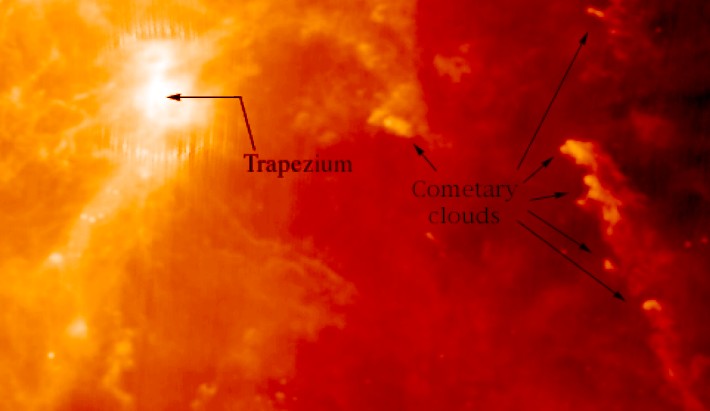
|
Explanation: Intense ultraviolet light from massive, hot stars in the Orion region has sculpted and compressed clouds of dust and gas in to distinctively shaped Cometary Globules. Seen in this IRAS infrared image recorded at a wavelength sensitive to emission from dust, the elongated globules are easily visible along with a bright region which corresponds to the Trapezium star cluster. Otherwise known as the Witch Head Nebula, IC 2118 is the string of globules near the middle right. Suggestively similar to comets in general appearance only, Cometary Globules are interstellar condensations on a vastly different scale. These are likely related to star formation episodes in the Orion molecular cloud. Besides those indicated by the arrows, more comet-shaped clouds or globules are present in this image.
|
January February March April May June July August September October November December |
| ||||||||||||||||||||||||||||||||||||||||||||||||
NASA Web Site Statements, Warnings, and Disclaimers
NASA Official: Jay Norris. Specific rights apply.
A service of: LHEA at NASA / GSFC
& Michigan Tech. U.
Based on Astronomy Picture
Of the Day
Publications with keywords: nebula - dust - Orion - star formation
Publications with words: nebula - dust - Orion - star formation
See also:
- Alnitak, Alnilam, Mintaka
- APOD: 2025 August 28 B Galaxies, Stars, and Dust
- APOD: 2025 July 10 B Lynds Dark Nebula 1251
- APOD: 2025 June 23 B W5: Pillars of Star Formation
- APOD: 2025 April 28 B Gum 37 and the Southern Tadpoles
- APOD: 2025 March 26 B Star Formation in the Pacman Nebula
- APOD: 2025 March 18 B LDN 1235: The Shark Nebula
